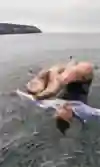Cliff diving is a captivating, enthralling pursuit that promises both a huge rush of adrenaline and a one-of-a-kind connection with nature. For many first-time cliff divers, the thrill lies in the pure adventure of leaping into the unknown.
“With a desire just to really push myself, I decided that high diving was where I wanted to take the leap,” Red Bull athlete and world-renowned cliff diver Rhiannan Iffland said about her beginnings in the sport. “I spent 18 months learning the skills needed for high diving from 10 meters (33 feet), then gradually moved up the heights, eventually arriving at cliff diving.”
Understanding cliff diving
Cliff diving is the act of jumping off a cliff or high platform into a body of water. It’s considered the world’s oldest extreme sport: its history traces back hundreds of years to the Hawaiian Islands, where Hawaiian chief King Kahekili would leap from cliffs to demonstrate his prowess.
Since those fear-defying leaps, cliff diving has evolved into a recognized sport, with events like the Red Bull Cliff Diving World Series. Here, divers from around the globe showcase their daring feats, strength, and flexibility.
Cliff diving locations can vary greatly. You’ll typically find natural settings like coastal cliffs and man-made platforms built by a body of water for improved accessibility. Cliff diving from man-made platforms is called platform jumping.

1 min
Cliffs of Moher - Heli Dive
Red Bull Cliff Diving - Cliffs of Moher - Helicopter Dive
Natural locations offer stunning, untouched beauty but require thorough scouting to ensure the water is deep enough and free of obstacles. Positano on the Amalfi Coast in Italy, the cliffs of Moher in Ireland, and Blue Hole in Dahab, Egypt, are among the world’s most famous natural cliff diving spots.
Platform jumping provides a controlled environment that may be better for newcomers to the sport, depending on the height of the jump. Notable platform jumping locations include the La Quebrada Cliff Divers in Acapulco, Mexico, and the Ponte Brolla Bridge in Switzerland.
01
How to execute a basic cliff dive

7 min
The perfect entry
The impact of hitting the water, known as the entry, is a crucial moment in the cliff diving routine.
Learning how to cliff dive involves a few basic key steps:
- Body positioning: Stand at the edge of the cliff, keep your arms close to your sides, and fix your gaze on the horizon to maintain your balance.
- Entry techniques: The way you enter the water is essential for a successful dive. As you leap, keep your body straight and your toes pointed to minimize impact when you hit the water. The goal is to enter the water feet-first to reduce risk of injury. This goes for both straight dives and if you’re doing somersaults on your way down.
- Minimizing impact: Tighten your core and keep your body streamlined to minimize your impact upon entry into the water.
In addition to practicing and perfecting your physical form, overcoming fear and building confidence are necessary for beginners. It can be quite easy to look down and flinch or move your body instinctively, but that can interfere with your form and a safe dive. You should start by working your way up—don’t go straight for the 27-meter jump. To become more comfortable, practice from lower heights and gradually increase to taller cliffs. Visualization techniques and positive affirmations will help you build mental resilience as well.
02
Training and preparation for cliff diving

4 min
Train like a Pro: High Diver Ellie Smart
High diver Ellie Smart takes us through a training session of stretches, sports psychology and an ice-cold plunge to top it off.
Physical conditioning is fundamental for cliff diving. Strong muscles, flexibility, agility, and effective breath control are essential components for your successful dive. Conditioning not only enhances your performance but also reduces the risk of injury.
- Strength and flexibility: Focus on exercises that build core strength, such as planks and leg raises. Yoga and dynamic stretching are also great ways to improve your flexibility. These workouts help you maintain control and form during your dive.
- Breath control: Practice breathing exercises to enhance your lung capacity and control. Techniques like diaphragmatic breathing (aka belly breathing) can improve your ability to stay calm.
- Mental preparation: Staying focused and calm under pressure is as important as physical readiness. Meditation and mindfulness exercises can help you manage your pre-dive nerves and maintain concentration during the dive while giving you confidence.
- Swimming: You need to be a strong swimmer to cliff dive. This ensures that you have the skills necessary to get yourself out of the water safely after your dive.
You may also want to practice out of the water before trying a real cliff dive. Professional cliff divers use trampolines and swimming pools to master their technique before conquering a dive.
03
Cliff diving safety tips
David Colturi at the Red Bull Cliff Diving World Series 2022 in Boston
© Romina Amato / Red Bull Content Pool
Cliff diving is risky, especially as the jumping surfaces climb higher and further from the water. Before heading to a cliff diving spot, remember these safety tips.
- Go to established diving spots. Beginners should only visit established spots where many before them have tried the jump. This provides assurance that the area is a clear, attainable dive.
- Inspect the diving area. Check for loose rocks, twigs, and other obstacles that could throw off your balance as you approach and prepare for the jump.
- Look into water depth. Shallow water risks injury. Make sure that the area where you’re jumping is deep enough; the recommended depth minimum is 10 feet.
- Check for obstacles. Rocks, fallen trees, and debris can lurk in the water and make the jump much riskier. Ensure that the water you’re diving into is clear.
- Breathe out your nose as you enter the water. This helps ensure that water doesn’t rush into your nasal cavity.
- Don’t push your limits. It takes time to work your way up to record-breaking heights. Start small and get comfortable before increasing your distance foot by foot. Don’t jump unless you are confident in your form and mental focus.
- Bring a friend. Don’t dive alone.
04
Cliff diving etiquette and environmental responsibility
David Colturi at the Red Bull Cliff Diving World Series 2022 at Copenhagen
© Romina Amato / Red Bull Content Pool
Responsible cliff diving extends beyond the jump. You need to respect the environment around you and show courtesy to other divers waiting to jump. This entails thorough preparation before diving, including environmental safeguards and etiquette toward other divers.
When you arrive at the cliff diving site, check the area for wildlife. Avoid disturbing any natural habitats in or out of the water. Practice “leave no trace” principles: do not leave litter behind, and don’t take anything from the cliff diving site with you. As the saying goes, leave only footprints.
It’s also important to show proper etiquette toward others around your dive. Be mindful of other divers and nature area visitors. Wait for your turn, show up prepared, and follow any posted guidelines or rules.
By adhering to these practices, you contribute to the preservation of diving sites and promote a positive, respectful community of divers to be part of.
Embrace the thrill
Cliff diving for beginners is an extraordinary journey into the world of adventure, physical challenge, and natural beauty. With the right preparation, respect for the sport and environment, and a mindful approach anyone can experience the exhilaration of leaping into the deep blue. So, take that first step, feel the rush of the free fall, and embrace the unique thrill cliff diving offers.










